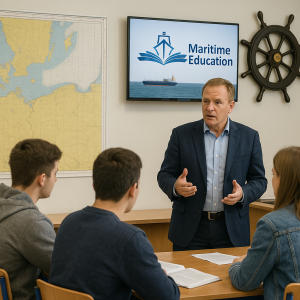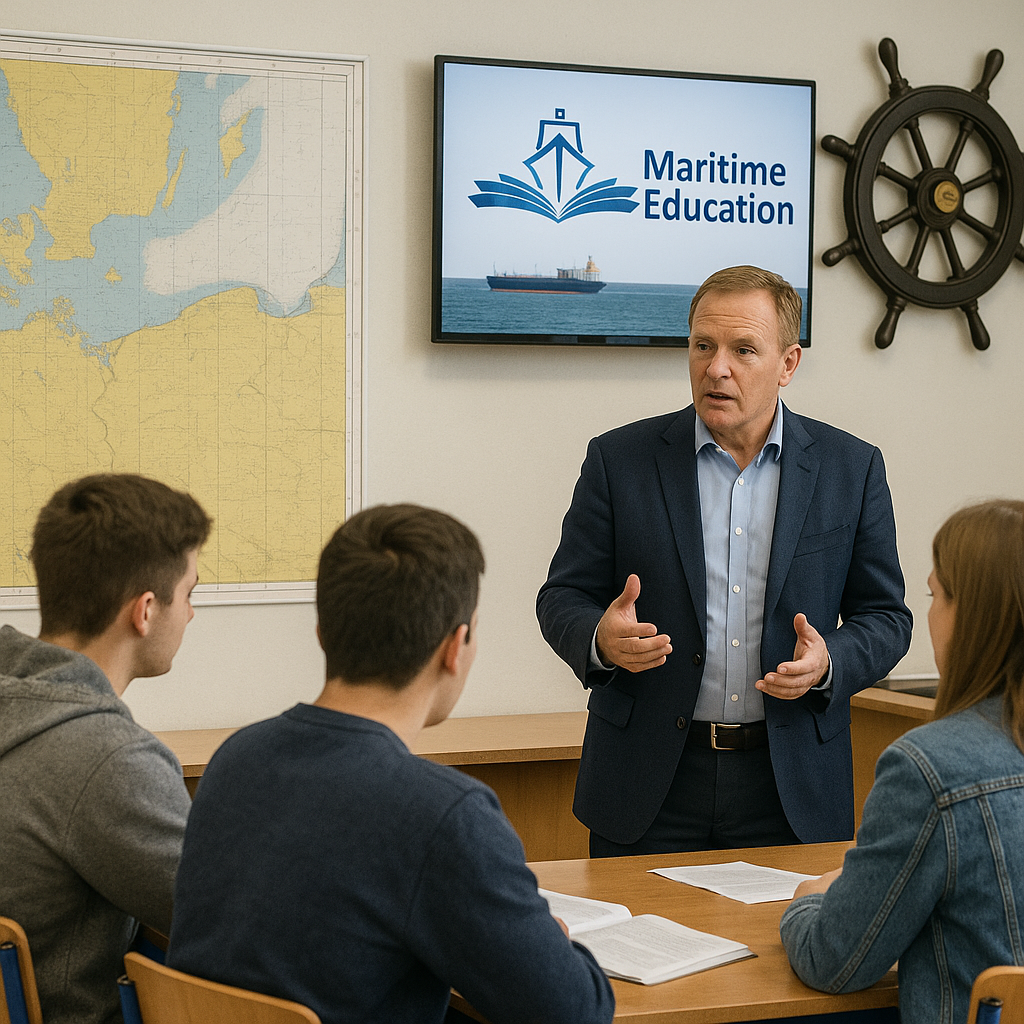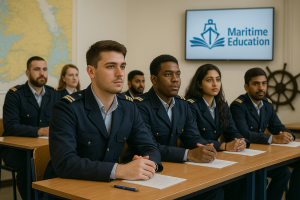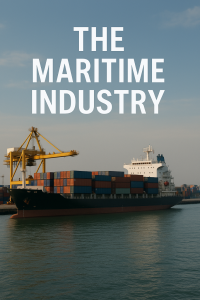Explore the world of maritime education in 2024 — training, certification, top schools, and career pathways for future seafarers, engineers, and maritime professionals.
What is Maritime Education?
 With over 1.8 million seafarers operating the global fleet and a maritime industry critical to world trade, maritime education forms the backbone of safe, efficient, and environmentally responsible shipping.
With over 1.8 million seafarers operating the global fleet and a maritime industry critical to world trade, maritime education forms the backbone of safe, efficient, and environmentally responsible shipping.
In this comprehensive guide, you’ll learn about the systems, standards, schools, and career pathways in maritime education, and why it’s a smart investment for the future.
Maritime education refers to the structured training, certification, and academic instruction of individuals preparing for careers at sea or in maritime-related industries.
It is governed primarily by international conventions like the STCW Convention and prepares professionals for roles ranging from ship officers and engineers to maritime business managers and environmental officers.
Key Components of Maritime Education
1. STCW Convention: The Foundation
The International Convention on Standards of Training, Certification, and Watchkeeping for Seafarers (STCW), established by the IMO, sets the global minimum standards for:
- Seafarer competency
- Certification processes
- Watchkeeping practices
- Safety and environmental awareness
🔎 Major revisions in 1995 and 2010 raised training standards and adapted to technological advancements.
2. Maritime Educational Institutions
| Institution Type | Focus |
|---|---|
| Nautical Schools | Basic training for deck and engine officers |
| Maritime Universities | Undergraduate and postgraduate degrees in maritime studies |
| Specialized Training Centers | Skill-specific certifications (e.g., ECDIS, firefighting, environmental safety) |
| Maritime Academies | Comprehensive officer training (e.g., USMMA, Philippine Merchant Marine Academy) |
3. Curriculum Structure
A balanced maritime curriculum typically includes:
- Theoretical Education: Navigation, engineering, marine law, environmental management
- Practical Training: Simulators, safety drills, on-board internships
- Sea Time Experience: Mandatory for certification and career progression
⚙️ Hands-on training remains a critical element in building seafarer competence.
4. Training and Certification Programs
Some common programs include:
- Bachelor of Science in Marine Transportation (BSMT): For deck officers and navigators.
- Bachelor of Science in Marine Engineering (BSMarE): For engineering officers and ETOs.
- Postgraduate Degrees: MSc in Maritime Studies, Naval Architecture, Maritime Law.
Certification is based on competency, not just course completion — evaluated via exams and practical assessments.
Global Overview: Leading Maritime Education Hubs
Southeast Asia
Countries like the Philippines, Indonesia, Malaysia, Singapore, and Vietnam are investing heavily in:
-
Simulator-based training
-
IMO-certified programs
-
English-language maritime education
📚 The Philippines alone supplies over 25% of the world’s seafarers.
Europe
Nations such as Greece, Norway, Germany, and the UK boast:
-
Historic maritime academies
-
Specialized research institutions
-
Advanced courses on green shipping and LNG vessels
North America
The United States Merchant Marine Academy (USMMA) and other maritime colleges (SUNY Maritime, Maine Maritime Academy) offer:
-
Officer licensing programs
-
Marine engineering and logistics degrees
-
Strong industry connections for internships and careers
Importance of Maritime Education
Maritime education is the backbone of the global shipping industry, ensuring safe, efficient, and sustainable maritime operations. With over 90% of world trade transported by sea, well-trained maritime professionals—from navigators to engineers—are essential for maintaining smooth logistics, preventing accidents, and protecting marine ecosystems. Quality maritime education equips cadets with technical expertise, leadership skills, and compliance knowledge under international regulations like STCW and IMO standards. As automation and green shipping technologies advance, continuous learning becomes crucial for adapting to new challenges. Investing in maritime education not only strengthens workforce competency but also drives innovation, economic growth, and environmental stewardship in the maritime sector.
-
Safety at Sea: Well-trained seafarers reduce accidents, prevent mechanical failures, and handle emergencies effectively.
-
Environmental Protection: Education on MARPOL regulations and green technologies minimizes pollution and supports sustainable shipping.
-
Industry Growth: A skilled workforce meets the global demand for efficient, safe, and technologically advanced maritime operations.
-
Economic Impact: Maritime trade generates trillions in global commerce; qualified personnel keep this ecosystem running smoothly.
Current Challenges and Future Trends in Maritime Education (2025+)
Challenges in Maritime Education
The maritime education sector faces significant challenges in 2025, including rapid technological advancements, crew shortages, and stricter environmental regulations. Many training institutions struggle to modernize curricula to include AI, autonomous vessels, and decarbonization strategies, leaving a skills gap among seafarers. Additionally, declining interest in maritime careers and high training costs hinder recruitment. However, future trends show promise with digital learning tools like VR simulations, AI-driven training modules, and remote learning platforms enhancing accessibility. The industry is also shifting toward competency-based training and sustainability-focused programs to meet net-zero goals. To stay competitive, maritime academies must embrace innovation, foster global collaboration, and align education with evolving industry demands.
-
Post-Pandemic Recovery:
Covid-19 disrupted training, certification, and sea-time accumulation. -
Digitalization and Automation:
Future officers need training on smart ships, autonomous systems, and cybersecurity. -
Environmental Regulations:
New IMO rules demand education on decarbonization, alternative fuels (LNG, ammonia), and emissions control.
Future Trends in Maritime Education
| Trend | Impact on Maritime Education |
|---|---|
| Green Shipping Focus | Courses on LNG, hydrogen, carbon capture |
| Digital Navigation and AI Systems | Training on e-navigation, remote ship management |
| Diversity and Inclusion | Global initiatives to attract more women and underrepresented groups |
🌱 Training programs are evolving rapidly to meet future maritime industry needs.
———————
FAQs: Maritime Education Explained
Q1: What is STCW certification?
A: It is a globally recognized set of qualifications that seafarers must achieve to work on international voyages.
Q2: Is a maritime degree necessary to work at sea?
A: No. Entry-level positions like deck ratings require STCW certification but not necessarily a degree. Officer roles typically require formal maritime education.
Q3: What are the best maritime universities?
A: Some top choices include the Philippine Merchant Marine Academy, World Maritime University (Sweden), and United States Merchant Marine Academy (USMMA).
Q4: How long does it take to become a ship officer?
A: Typically 3–4 years, including coursework and mandatory sea-time.
Q5: Can maritime education lead to shore-based careers?
A: Absolutely. Graduates often work in ship management, logistics, marine insurance, research, and port operations.
Conclusion
Choosing maritime education unlocks exciting possibilities — global travel, career stability, leadership opportunities, and a chance to contribute to sustainable global trade.
Whether you’re aiming to captain a vessel, manage a fleet, or innovate the future of green shipping, maritime education provides the strong foundation you need.
🌊 The oceans are calling. Are you ready to answer?
Further Reading and Resources
-
Maritime Education and Training – An in-depth look at the structure, institutions, and international standards shaping maritime education and training.Maritime Education+3Maritime Education+3Maritime Education+3
-
Career Opportunities and Training Programs in the Maritime Industry – Explore key maritime career paths, top training programs, and job progression opportunities.Maritime Education
-
The Life of a Seafarer: Challenges, Opportunities, and Lifestyle – Insights into the pros and cons of working as a seafarer, delving into the lifestyle and support systems in place.Maritime Education
-
Ship Ratings: Roles, Responsibilities, and Career Insights – Detailed information on the ranks, roles, and responsibilities of ship ratings, including career progression.Maritime Education
-
Promoting Gender Equality and Inclusion in Maritime Careers – An exploration of the progress, challenges, and efforts towards creating a more inclusive maritime industry.International Maritime Organization+4Maritime Education+4Maritime Education+4




That`s right.
Good and I informative!
Aw, this was an extremely good post. Taking the
time and actual effort to make a good article… but what can I say… I procrastinate a lot and never seem
to get nearly anything done.
A perfect guide on maritime education an training. Thank you maritimeducation.com